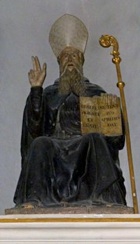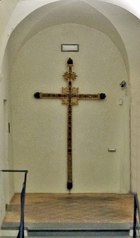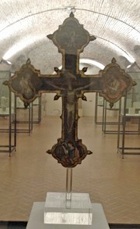

Badia di Petroia (10th century)
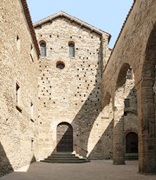
This abbey was first documented in 972, when it belonged to the Bourbon del Monte family. It passed to the city of Città di Castello before 1403. The abbey itself has been transformed by subsequent development, but part of its church, which is dedicate as Santa Maria e Sant’ Egidio, survives.
The current facade of the church was built in the 14th century, when two thirds of the nave were demolished. The newly-discovered arcade on the left of what is now a courtyard in front of it belonged to the original construction.
The crypt under the apse is currently closed for restoration, following damage suffered in the earthquake of 1997.
Istituto Sacro Cuore (1920)
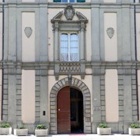
The complex now occupies the entire “island bounded by Via XI Settembre, Via San Girolamo and Via Trastevere. The complex now acts as the nuns’ headquarters in Città di Castello and includes the their church of Santa Lucia (open to the public only on the feast of St Lucy, 13th December) and an old people’s home. The nuns also run a primary school in nearby Pomerio San Girolamo.
Sant’ Antonio Abate (14th century)
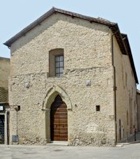
The city authorities had begun negotiations for the establishment of a Jesuit church and college in Città di Castello in 1572, initially without success. In the period of 1609-61, they enlarged the church church and moved its entrance to to a newly-established piazza (now Piazza Gioberti). However, there were then problems with finance, and the Jesuits withdrew from the city. After their return in 1682, the Jesuits bought adjoining properties from Chiappino Vitelli and used the site for their college. Further enlargement of the church was carried out in 1699.
When the Jesuits were suppressed in 1773, the complex passed to the nuns of Santa Margherita. They remained here until ca. 1790, at which point they moved to the Monastero di SS Benedetto ed Egidio.
Pope Pius VII re-instituted the Jesuits in 1814, and negotiations for their return to Città di Castello began in 1823. There was considerable political opposition, but they finally returned in 1844. They negotiated with Luigi Bufalini on a 99 year lease on Palazzo Bufalini in order to build a new college, and secured the approval of Pope Pius IX for the project. The college opened in 1846 but the political situation deteriorated and the Jesuits were driven from the city in 1848.
The church, which had a number of subsequent uses, was opened as an auditorium in 2006. The ex-college now belongs to the Monte dei Paschi di Siena.
Statutes (14th -15th century)

These statutes of the Compagnia di Sant’ Antonio Abate in the Museo del Duomo presumably came from the confraternity’s premises here.
Scenes from the Life of St Antony Abbot (late 14th century)
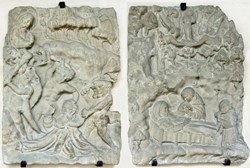
These two reliefs in the lower loggia in the Pinacoteca Comunale, which came from Sant’ Antonio Abate, depict:
-
✴St Antony Abbot tempted by demons, as God the Father looks down from Heaven; and
-
✴the death of St Antony Abbot and the ascent of his soul, carried by angels.
St Antony Abbot Enthroned [15th century ?]
SS Apollinare e Lucia (15th century)
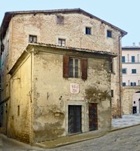
Santa Barbara (1647)
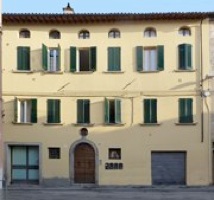
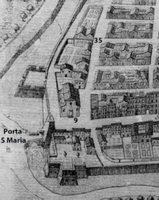
This ex-oratory [35] was built for the Confraternita di Santa Barbara. It stands against the city wall, on the site of an ancient church of this name that had been demolished to facilitate the fortification of the city during the First War of Castro (1639).
Panels (1675)
An 18th century manuscript records that a local artist named Giovanni Francesco Panichi painted scenes in lunettes in the tribune of the oratory, using designs by Pietro Montanini, and that the latter retouched them. These lunettes depict:
-
✴the martyrdom of St Barbara; and
-
✴the Annunciation to the Shepherds.
Scenes from the Life of St Barbara (1684)
These frescoes by Mattia Batini are in the vaults of the oratory.
San Bartolomeo (13th century)
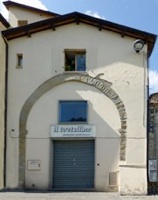
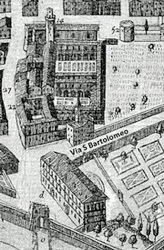
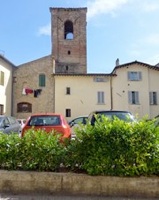
Detail from the plan (ca. 1675) of
Città di Castello by Filippo Titi
(Biblioteca Comunale “Giosue Carducci”)
This church Via San Bartolomeo was documented in 1256 as a possession of the Badia di Subcastelli, near Sansepolcro. The Franciscans built their convent next to it in ca. 1266. They attempted to acquire the church itself in 1273, but this was vetoed by Bishop Nicolò. (The Franciscans therefore built the new church of San Francesco [14]
It is now a pasta shop (illustrated on the left), and is only recognisable as an ex-church because its campanile can still be seen from the space behind it. The Vitelli family apparently built this campanile, which was once decorated with the family arms.
San Bartolomeo Triptych (ca. 1430)
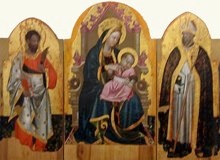
This triptych from San Bartolomeo, which is attributed to Antonio Alberti da Ferrara, was moved to the Vitelli Chapel in San Francesco in 1921 and to the Pinacoteca Comunale in 1931. It depicts the Madonna and Child enthroned in the central panel, flanked by SS Bartholomew and Benedict.
Martyrdom of St Bartholomew (17th century)
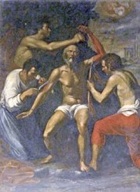
Chiesa di Buon Consiglio (1588-1594)
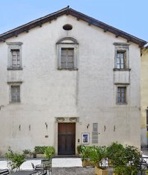
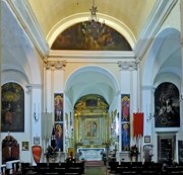
This church in Via del Popolo (which was previously known as Santa Maria del Popolo) belongs to the Confraternita del Buon Consiglio della Buona Morte e Misericordia. It incorporates as its sacristy the ancient Cappella della SS Annunziata, a chapel used by those condemned to death.
A fresco [date ??] on the wall of the earlier church, which depicted the Madonna and Child with SS Antony Abbot and Catherine of Alexandria and was known as the Madonna del Buon Consiglio, was deemed to have performed a miracle in the late 16th century. The church was duly rebuilt to house it with greater honour. Bishop Ludovico Bentivoglio laid the foundation stone in 1588 and the detached fresco was installed on its high altar in 1594. [Is it still behind the shutters above the altar ??]. Bishop Giovanni Battista Lattanzi restored the church in 1757, at which point it took on its present appearance.
The church is now used by a lay confraternity known as the Templari di San Bernardo.
St Crescentian (early 17th century)
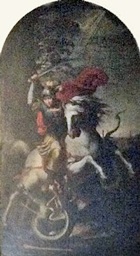
Santa Caterina (demolished 1942)
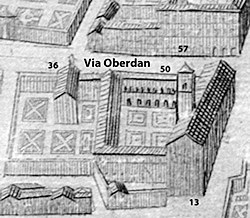
Detail from the plan (ca. 1675) of
Città di Castello by Filippo Titi
(Biblioteca Comunale “Giosue Carducci”)
The Oratorio di Santa Caterina [36] belonged to the penitent Confraternita di Santa Caterina, which was documented outside Città di Castello [at Ponte di Nuvole] in 1256. The Dominicans gave the brothers what had been the church of San Pietro di Massa in 1367, on condition that they carried out necessary repairs to it. The church then became known as the Oratorio di Santa Caterina.
The Dominicans, who had moved to a new church of Santa Maria della Carita [50] by that time, subsequently moved to the larger church, San Domenico [13]. As their convent took shape, the oratory was surrounded by its orchard. It was demolished in 1942 to make way for an extension to the tobacco factory.
There is an old photograph of the facade of the oratory in this page of a website by Alvaro Tacchini that describes the establishment of the the tobacco factory.
Art from the Oratory
Processional Standard (16th century)
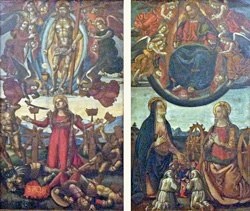
This double-sided standard from the oratory, which is by an unknown artist, was documented in the sacristy of the oratory and moved to the Pinacoteca Comunale in ca. 1878:
-
✴one side depicts a scene from the martyrdom of St Catherine of Alexandria, in which the wheel on which she is being tortured shatters as she meditates on an image of the risen Christ; and
-
✴the other side depicts the Virgin and St Catherine interceding with Christ for the people of Città di Castello and, in particular, for members of the confraternity (identified by their white robes).
Mystical Marriage of St Catherine
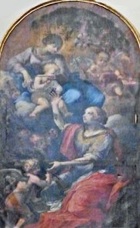
San Crescentino di Morra (1420)
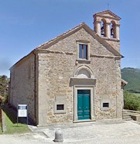
Frescoes (15th century)
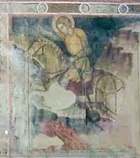
Frescoes (1507-10)
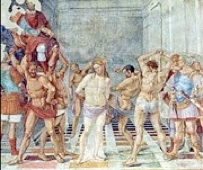
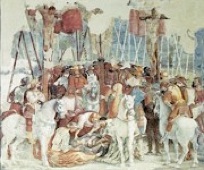
The frescoes in the church are mostly attributed to Luca Signorelli and his workshop. They comprise:
-
✴those in the niche behind the high altar, which depict the Risen Christ with St Mary Magdalene and an unidentified hermit saint;
-
✴those in niches in the side walls, which depict:
-
•the Madonna di Loreto, on the left; and
-
•the Madonna della Misericordia with members of the confraternity, on the right; and
-
✴scenes from the Passion:
-
•on the left:
-
-Christ in the Garden of Gethsemane;
-
-the Last Supper; and
-
-the Flagellation (illustrated above); and
-
•on the right, the Crucifixion (illustrated above), of which only the lower part survives.
Santa Croce (14th century)
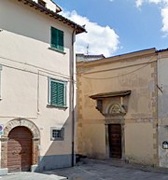
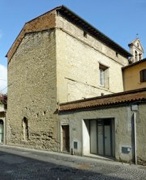
Facade in Piazza del Garigliano Campanile seen from Via Signorelli
This church, which belonged to the Confraternita di Santa Croce, was documented from 1339. It was closed after the earthquake of 1789.
Art from the Church
Processional Cross (17th century)
Sant’ Egidio (13th century)
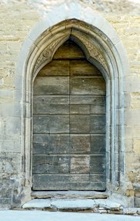
The church passed to the Somaschi Fathers in the early 17th century and then to the Duomo in 1837. It was deconsecrated after the First World War. The Blessed Charles Liviero established a cinema for children here in 1931. The building was abandoned in the 1980s and remains closed, despite a restoration that was carried out in 2010.
San Filippo Neri (1668)
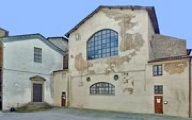
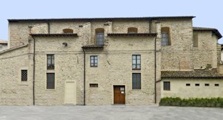
Oratorio degli Angeli (to the left) Right wall of church
and facade of church
A church on this site dedicated as San Pietro della Scatorbia was documented in 1232. The site passed to the Oratorian Fathers in 1622. In 1633, Pope Urban VIII gave permission for the translation of the relics of SS Albert and Brictius to be translated to the church from the church of San Pietro di Boneporte, near Villa di Grumale, outside Città di Castello. This provided funds for a new church, which was designed by Nicolò Barbioni. They also commissioned the adjacent Oratorio degli Angeli (1687). The community was suppressed in 1860 and the complex housed the Pinacoteca Comunale in 1876-1912.
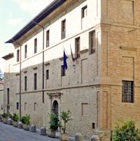
Art from the Church
St Peter and the Risen Christ (1718-9)
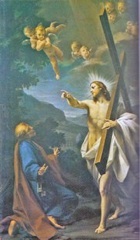
San Giovanni Decollato (14th century)
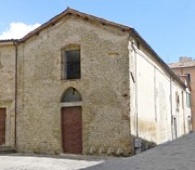
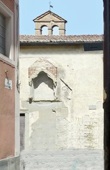
This church belonged to the Confraternita di San Giovanni Decollato, which was documented in 1367, and which Pope Urban VIII associated with the Compagnia di San Giovanni Decollato, Rome in 1642. This confraternity assisted those condemned to death.
The church has its main entrance in Via San Girolamo and its side entrance in Via Sant’ Andrea. Its campanile can be seen to the right of this side entrance (photographed to the right here here from Via della Fraternita). The building to the left of the facade now houses the Oratorio San Giovanni Bosco.
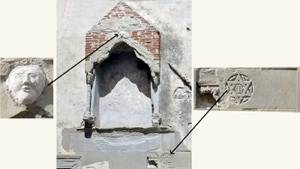
The aedicule below the campanile has an interesting relief at its apex. The star of David below it suggests that this building might once have been used as a synagogue.
Frescoes
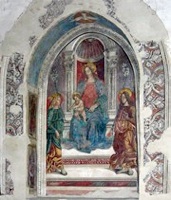
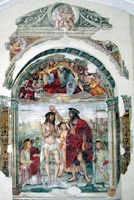
These surviving frescoes in the church depict:
-
✴the Madonna and Child enthroned with two angels, which is dated by inscription to 1495; and
-
✴the Baptism of Christ with St John the Evangelist [and ???], with God the Father in glory above (16th century).
Art from the Church
Gonfalon (ca. 1500)
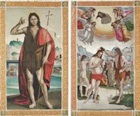
-
✴One face depicts St John the Baptist and three scenes from his life:
-
•St John in the desert;
-
•the trial before Herod; and
-
•the feast of Herod.
-
✴The other face depicts the Baptism of Christ.
The work is generally though to be from the workshop of Luca Signorelli. Following its restoration in 2011, Tom Henry (2012, referenced in the page on the artist) judged that the first side was indeed probably a workshop production, but that the second side was probably largely the work of Signorelli himself.
Santa Maria Maggiore (1483-1509)
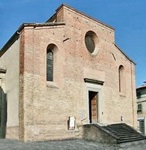
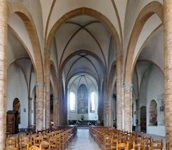
The earlier church (13th century) on the site had been the parish church of the Vitelli family, whose home was in nearby Via della Mattonata.
Shortly after his recapture of Città di Castello, Nicolò Vitelli commissioned the present church from Elia di Bartolomeo Lombardo. It was built using material recovered after the demolition of the nearby papal fortress.
The church was restored in the 20th century.
Choir Stalls (1581)
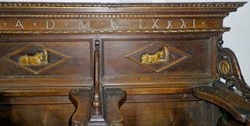
Beatrice Vitelli commissioned these choir stalls for the Monastero di Ognisanti (of which she was the abbess). They are dated by inscription and carry the Vitelli arms. They were documented in the church on a number of occasions in the period 1728-1878 and subsequently became part of the civic collection. They were moved here in the 1950s and adapted to fit the polygonal presbytery.
Santa Maria della Neve (15th century)
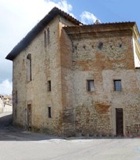
Santa Maria Nuova (ca. 1789)
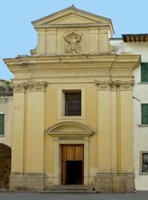
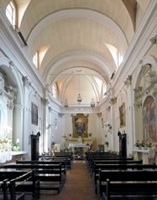
An ancient church here, which was documented in 1197, was rebuilt after the earthquake of 1789.
Crucifixion (16th century)
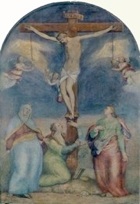
Madonna and Child with saints (17th century)
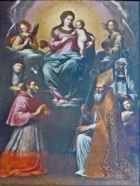
San Michele Arcangelo (18th century)
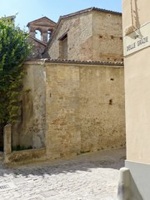
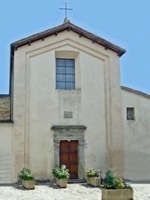
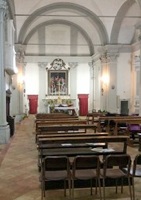
Giulio Vitelli gave this ancient church to the Servite friar Sebastiano Sellari in 1527. It was rebuilt after the earthquake of 1789. It still operates as a parish church.
Madonna and Child with Saints (ca. 1530)
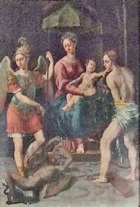
Art from the Church
Painted Cross (16th century)
San Sebastiano (1478)
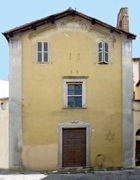
SS Spirito (17th century)
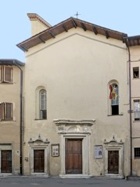
Santo Stefano, later Sant’ Illuminato (ca. 1230)
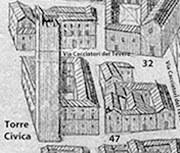
Detail from the plan (ca. 1675) of Città di Castello
by Filippo Titi (Biblioteca Comunale “Giosue Carducci”)
According to tradition, Santa Stefano was the first duomo of Città di Castello, which was destroyed by Totila in the 6th century. Traces of it were discovered in 2003-6 during the restoration of Palazzo Vescovile and can be seen in the Sala di Santo Stefano inside the palace.
This church [47] was rebuilt behind Palazzo Vescovile and dedicated as Sant’ Illuminato after the presumed relics of this saint were brought here from nearby Castello di Monte Albano in 1230. The new church, which belonged to the Università dei Sartori (tailors’ guild), was subsequently demolished.
Teatro degli Illuminati (1666)
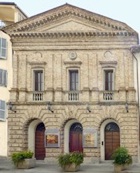
The theatre was closed after the First World War, but restored and reopened in in 1920. It passed to the Commune in 1939.
The theatre, which can hold an audience of some 400 people, is still in use.
Terme di Fontecchio (1868)
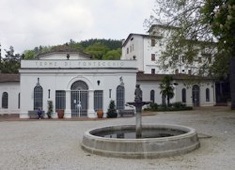
The earlier baths on this site by the Scatorbia, some 3 km upstream from Città di Castello, were destroyed by an earthquake in 1789. The Commune commissioned Guglielmo Calderini to design the current Terme di Fontecchio, which was restored and remodelled in 1949.
Excavations here in 1868 unearthed evidence of a Roman spa that might have been the one enjoyed by Pliny the Younger and his wife, Calpurnia. A Roman inscription (CIL XI 5942) that was also apparently found here alludes to the fact that a man whose name can no longer be deciphered had left a considerable amount of money and a building for housing the baths for “the commonwealth of Tifernum Tiberinum”. The inscription, which is now in Palazzo Comunale, actually records a legal ruling reducing the bequest in favour of other potential beneficiaries.
Return to Monuments of Città di Castello.
Return to: Walk I (SS Apollinare e Lucia; Santa Barbara; Chiesa di Buon Consiglio;
Santa Caterina; Santa Croce; San Filippo Neri; Santa Maria Maggiore; Santa Maria Nuova; San Sebastiano; Santo Spirito; Santo Stefano, later Sant’ Illuminato); or
Walk II (Istituto Sacro Cuore; Sant’ Antonio Abate; San Bartolomeo; Sant’ Egidio;
San Filippo Neri; San Giovanni Decollato; Santa Maria della Neve;
San Michele Arcangelo; Santa Veronica; Teatro degli Illuminati)
Excursions from Città di Castello (Badia di Petroia; San Crescentino di Morra;
Terme di Fontecchio)
